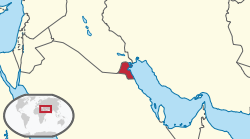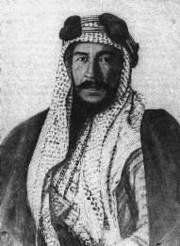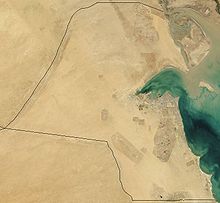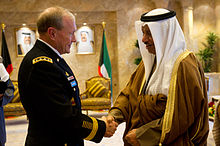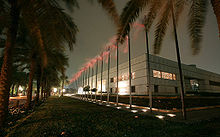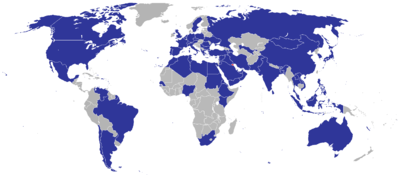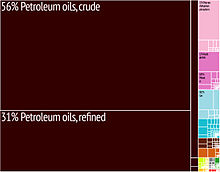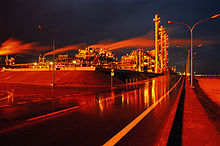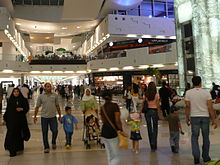
Kuwait
Did you know...
SOS Children, an education charity, organised this selection. To compare sponsorship charities this is the best sponsorship link.
| State of Kuwait دولة الكويت
Dawlat al-Kuwait |
||||||
|---|---|---|---|---|---|---|
|
||||||
| Anthem: " Al-Nasheed Al-Watani" "National Anthem" |
||||||
|
Location and extent of Kuwait (red) on the Arabian Peninsula.
|
||||||
| Capital and largest city |
Kuwait City 29°22′N 47°58′E |
|||||
| Official languages | Arabic | |||||
| Ethnic groups | ||||||
| Demonym | Kuwaiti | |||||
| Government | Unitary hereditarya constitutional monarchyb |
|||||
| - | Emir | Sabah Al-Ahmad Al-Jaber Al-Sabah | ||||
| - | Prime Minister | Jaber Al-Mubarak Al-Hamad Al-Sabah | ||||
| Legislature | National Assembly | |||||
| Establishment | ||||||
| - | First settlement | 1703 | ||||
| - | Anglo-Ottoman Convention | 1913 | ||||
| - | Independence from the United Kingdom |
19 June 1961 |
||||
| Area | ||||||
| - | Total | 17,820 km2 ( 157th) 6,880 sq mi |
||||
| - | Water (%) | negligible | ||||
| Population | ||||||
| - | 2012 estimate | 2,818,042 ( 131st) | ||||
| - | 2005 census | 2,213,403 | ||||
| - | Density | 200.2/km2 ( 61st) 518.4/sq mi |
||||
| GDP ( PPP) | 2011 estimate | |||||
| - | Total | $163.671 billion ( 58th) | ||||
| - | Per capita | $58,080 ( 5th) | ||||
| GDP (nominal) | 2012 estimate | |||||
| - | Total | $173.240 billion ( 52nd) | ||||
| - | Per capita | $45,824 ( 8th) | ||||
| HDI (2013) | high · 54th |
|||||
| Currency | Kuwaiti dinar ( KWD) |
|||||
| Time zone | AST / KSA ( UTC+3) | |||||
| - | Summer ( DST) | not observed ( UTC+3) | ||||
| Date format | dd/mm/yyyy ( CE) | |||||
| Drives on the | right | |||||
| Calling code | +965 | |||||
| ISO 3166 code | KW | |||||
| Internet TLD | .kw | |||||
| a. | Nominal succession within the House of Sabah. | |||||
| b. | Emirate / princedom. | |||||
Kuwait, officially the State of Kuwait / k uː ˈ w eɪ t / (Arabic: دولة الكويت Dawlat al-Kuwayt ), is an Arab country in Western Asia. Situated in the northeastern edge of the Arabian peninsula at the tip of the Persian Gulf, it shares borders with Iraq to the north and Saudi Arabia to the south. The name "Kuwait" is derived from the Arabic أكوات ākwāt, the plural of كوت kūt, meaning "fortress built near water". The country covers an area of 17,820 square kilometers (6,880 square miles) and has a population of about 2.8 million.
Historically, the region was the site of Characene, a major Parthian port for trade between Mesopotamia and India. The Bani Utbah tribe were the first permanent settlers in the region, laying the foundation for the modern emirate. By the 19th century, Kuwait came under the influence of the Ottoman Empire. After World War I, it emerged as an independent sheikhdom under the protection of the British Empire. Kuwait's large oil fields were discovered in the late 1930s.
After Kuwait gained independence from the United Kingdom in 1961, the state's oil industry saw unprecedented economic growth. In 1990, Kuwait was invaded and annexed by neighboring Iraq. The seven month-long Iraqi occupation came to an end after direct military intervention by United States-led forces. Around 773 Kuwaiti oil wells were set ablaze by the retreating Iraqi army, resulting in a major environmental and economic catastrophe. Kuwait's infrastructure was badly damaged during the war and had to be rebuilt. Twelve years later, Kuwait saw another massive foreign military presence as it served as a springboard for the U.S.-led campaign in 2003 to oust Ba'athist Iraqi leader Saddam Hussein.
Kuwait is a constitutional emirate with a parliamentary system of government. Kuwait City serves as the country's political and economic capital. Kuwait is often described as the most liberal country in the region. The country has the world's fifth largest oil reserves and petroleum products now account for nearly 95% of export revenues and 80% of government income. Kuwait is the eleventh richest country in the world per capita and, in 2007, had the highest human development index (HDI) in the Arab world. Kuwait is classified as a high income economy by the World Bank and is designated as a major non-NATO ally of the United States.
History
In the 4th century BC, the ancient Greeks colonized an island off Kuwait's coast, naming it "Ikaros". It is now known as Failaka. By 123 BC, the region came under the influence of the Parthian Empire and was closely associated with the southern Mesopotamian town of Charax. In 224 AD, the region fell under the control of Sassanid Empire and came to be known as Hajar. By the 14th century, the area comprising modern-day Kuwait had become a part of the Islamic caliphate.
The first permanent settlers in the region came from the Bani Utbah tribe, who later established the state of Kuwait. The region became part of the Ottoman Empire in the early 17th century. The site of present-day Kuwait City was first settled in the early 18th century and had become a busy trading hub by the early 19th century. In 1756, Kuwait came under the rule of Sabah I bin Jaber as the first Emir of Kuwait, who enjoyed a degree of semi-autonomy under the Ottomans. The current ruling family of Kuwait, al-Sabah, are descendants of Sabah I. During the rule of the Al-Sabah, Kuwait progressively became a centre of trade and commerce. It now served as a hub of trade between India, the horn of Africa, the Nejd, Mesopotamia and the Levant. Until the advent of Japanese pearl farming, Kuwait had one of the largest sea fleets in the Persian Gulf region and a flourishing pearling industry. Trade consisted mainly of pearls, wood, spices, dates and horses.
British Kuwait
In 1899, fearing direct rule from the Ottomans, Sheikh Mubarak Al-Sabah entered into a treaty with Britain by which Kuwait became a protectorate. Britain provided naval protection and an annual subsidy in return for allowing London to control its foreign affairs. This treaty was primarily prompted by fears that the proposed Berlin-Baghdad Railway would lead to an expansion of German influence in the Persian Gulf. After the signing of the Anglo-Ottoman Convention of 1913, Sheikh Mubarak, was diplomatically recognized by both the Ottomans and British as the ruler of the autonomous caza of the city of Kuwait and the hinterlands. However, soon after the start of World War I, the British invalidated the convention and declared Kuwait an independent principality under the protection of the British Empire. The 1922 Treaty of Uqair set Kuwait's border with Saudi Arabia and also established the Saudi-Kuwaiti neutral zone, an area of about 5,180 km² adjoining Kuwait's southern border.
Large oil reserves were discovered by the US-British Kuwait Oil Company in 1937. Exploitation was delayed by World War II, but thereafter fueled the country's development into a modern commercial centre. A major public-works programme began in 1951; Kuwait's infrastructure was transformed, and residents began to enjoy a high standard of living. By 1952, the country became the largest exporter of oil in the Persian Gulf region. This massive growth attracted many foreign workers, especially from Egypt and India.
Independence
On 19 June 1961, Kuwait became independent with the end of the British protectorate; the sheikh Abdullah III Al-Salim Al-Sabah, became an emir, and the country joined the Arab League. Iraq laid claim that Kuwait was part of its territory, but formally recognized Kuwait's independence and its borders in October 1963. Under the terms of a newly drafted constitution, Kuwait held its first parliamentary elections in 1963. However, the Emir suspended the National Assembly in 1976, saying it was not acting in the country's interests.
The exploitation of large oil fields, especially the Burgan field, transformed Kuwait into a rich country. Kuwait settled its boundary disputes with Saudi Arabia and agreed on sharing equally the Saudi–Kuwaiti neutral zone's petroleum reserves. During the 1970s, the Kuwaiti government nationalized the Kuwait Oil Company, ending its partnership with Gulf Oil and British Petroleum.
In the early 1980s, Kuwait experienced a major economic crisis after the Souk Al-Manakh stock market crash and decrease in oil price. This prompted the Emir Jaber Al-Ahmad Al-Jaber Al-Sabah to recall the National Assembly in 1981. However, the crisis was short-lived as Kuwait's oil production increased steadily to fill the gap caused by decrease in Iraq's and Iran's oil production due to the Iran–Iraq War. The National Assembly was dissolved again in 1986.
During the Iran-Iraq war in the 1980s, Kuwait supported Iraq. In 1983, the Shiite Dawa Party carried out a series of bombings, in opposition to Kuwait's support of Iraq. After the war ended, Kuwait declined an Iraqi request to forgive its US$65 billion debt. An economic rivalry between the two countries ensued after Kuwait increased its oil production by 40 percent. Tensions between the two countries increased further in July 1990, after Iraq complained to Opec that Kuwait was stealing its oil from a field near the border by slant drilling of the Rumaila field.
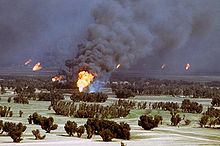
On 2 August 1990, Iraqi forces invaded and annexed Kuwait. After a series of failed diplomatic negotiations, the United States led a coalition to remove the Iraqi forces from Kuwait, in what became known as the Gulf War. On 26 February 1991, the coalition succeeded in driving out the Iraqi forces. As they retreated, Iraqi forces carried out a scorched earth policy by setting on fire oil wells. During the Iraqi occupation, about 1,000 Kuwaiti civilians were killed and more than 300,000 residents fled the country.
The Emir and his government returned in March 1991 and imposed a three-month period of martial law. Kuwait paid the coalition forces US$17 billion for their war efforts. Under domestic and international pressure, Emir Jaber reluctantly gave the green light to parliamentary elections in 1992. In 1993 the UN demarcated the new Kuwait-Iraq border, and Iraq officially recognised Kuwait's independence and the UN-demarcated borders in 1994.
The Emir once again dissolved the National Assembly in 1999; liberals and Islamists predominated in the resulting parliamentary elections. In March 2003 Kuwait became the springboard for the US-led invasion of Iraq. Islamist and pro-government candidates fared well in the parliamentary elections of 2003. In May 2005, parliament approved a law allowing women to vote and run for parliament for the first time. In June the first woman cabinet minister, Massouma al-Mubarak, was appointed.
Upon the death of the emir, Sheikh Jaber, in January 2006, the crown prince, Sheikh Saad Al-Sabah, succeeded him but was removed nine days later because of concerns about his ailing health. Sheikh Sabah Al-Sabah was sworn in as Emir. Emir Sabah named his brother, Sheikh Nawaf Al-Sabah, as crown prince and his nephew Sheikh Nasser Al-Sabah as prime minister.
Parliamentary elections were held in 2006. The opposition - a loose alliance of reformists, liberals and Islamists - won nearly two-thirds of the seats despite government attempts to curb media freedoms. Emir Sabah dissolved parliament in March 2008. Radical Islamists made further gains in parliamentary elections in May 2008, winning more than half of the 50 seats. Emir Sabah dissolved parliament again after it wanted to question his nephew and PM, Sheikh Nasser over corruption allegations in March 2009. Three women MPs – Kuwait's first – won seats in the parliamentary elections of 2009.
In 2011-2012 there were protests inspired by the Arab Spring. Emir Sabah dissolved parliament again in December 2011. He replaced his prime minister following protests and a showdown over allegations of high-level corruption. In parliamentary elections in February 2012, the Islamist-led opposition won a majority. Emir Sabah blocked a proposal by MPs to make all legislation comply with Islamic law. In October 2012, the Emir dissolved parliament for the fourth time in four years, paving the way for snap elections. The elections of December 2012 were boycotted by the opposition protesting against proposed changes to the electoral law which would give official candidates an advantage.
Geography
Located in the north-east corner of the Arabian Peninsula, Kuwait is one of the smallest countries in the world in terms of land area. It lies between latitudes 28° and 31° N, and longitudes 46° and 49° E. The flat, sandy Arabian Desert covers most of Kuwait. The country is generally low lying, with the highest point being 306 m (1,004 ft) above sea-level. It has nine islands, all of which, with the exception of Failaka Island, are uninhabited. With an area of 860 km2 (330 sq mi), the Bubiyan is the largest island in Kuwait and is connected to the rest of the country by a 2,380 m (7,808 ft) long bridge. The land area is considered arable and sparse vegetation is found along its 499 km long coastline. Kuwait City is located on Kuwait Bay, a natural deep-water harbour.
Kuwait has some of the world's richest oil fields with the Burgan field having a total capacity of approximately 70 billion barrels (1.1×1010 m3) of proven oil reserves. During the 1991 Kuwaiti oil fires, more than 500 oil lakes were created covering a combined surface area of about 35.7 km2 (13.8 sq mi). The resulting soil contamination due to oil and soot accumulation had made eastern and south-eastern parts of Kuwait uninhabitable. Sand and oil residue had reduced large parts of the Kuwaiti desert to semi-asphalt surfaces. The oil spills during the Gulf War also drastically affected Kuwait's marine resources.
Climate
The spring season in March is warm and pleasant with occasional thunderstorms. The frequent winds from the northwest are cold in winter and spring and hot in summer. Southeasterly winds, usually hot and damp, spring up between July and October; hot and dry south winds prevail in spring and early summer. The shamal, a northwesterly wind common during June and July, causes dramatic sandstorms. The temperature in Kuwait during summer is above 25 (77 F). The highest recorded temperature was 54.4 (129.9 F) which is the highest of any Middle Eastern country.
| Climate data for Kuwait | |||||||||||||
|---|---|---|---|---|---|---|---|---|---|---|---|---|---|
| Month | Jan | Feb | Mar | Apr | May | Jun | Jul | Aug | Sep | Oct | Nov | Dec | Year |
| Average high °C (°F) | 19.5 (67.1) |
21.8 (71.2) |
26.9 (80.4) |
33.9 (93) |
40.9 (105.6) |
45.5 (113.9) |
47.3 (117.1) |
44.5 (112.1) |
43.7 (110.7) |
36.6 (97.9) |
27.8 (82) |
21.9 (71.4) |
34.19 (93.53) |
| Average low °C (°F) | 7 (45) |
9 (48) |
13 (55) |
18 (64) |
24 (75) |
27 (81) |
29 (84) |
28 (82) |
24 (75) |
19 (66) |
13 (55) |
8 (46) |
18.3 (64.7) |
| Precipitation mm (inches) | 25.4 (1) |
15.2 (0.598) |
12.7 (0.5) |
15.2 (0.598) |
5.1 (0.201) |
0.20 (0.0079) |
0 (0) |
0 (0) |
0 (0) |
2.5 (0.098) |
12.7 (0.5) |
17.8 (0.701) |
106.8 (4.2039) |
| Source: weather.com | |||||||||||||
Politics
Kuwait is a constitutional monarchy and has the oldest directly elected parliament among the Arab States of the Persian Gulf. The country has been ruled by the Al Sabah family since the 18th century. The head of state is the Emir or Sheikh, a hereditary office. A council of ministers, also known as cabinet ministers, aids the Prime Minister, and appoints and dismisses diplomats.
The Kuwaiti parliament has a say in the appointment of the Emir. The parliament (per article 3 of the constitution) has a constitutional right to approve or disapprove of an Emir's appointment. The parliament effectively removed then crown prince Sheikh Saad after the death of Sheikh Jaber Al-Sabah in early 2006 due to Saad's inability to rule because of illness. Legislative power is vested in the Emir and the National Assembly in accordance with the Constitution. The Emir of Kuwait can dissolve the National Assembly but must subsequently call a national election.
The National Assembly consists of fifty elected members, who are chosen in elections held every four years. Government ministers are also granted membership in the parliament and can number up to sixteen excluding the fifty elected members. According to the Constitution of Kuwait, nomination of a new Emir or Crown Prince by the ruling Al-Sabah family has to be approved by the National Assembly. Any amendment to the constitution can be proposed by the Emir but it needs to be approved by more than two-thirds of the members of the National Assembly before being implemented.
There have been several conflicts between the Emir, the government and the National Assembly over various policies. The National Assembly was suspended from 1976 to 1981, from 1986 to 1991 and from May 1999 to July 1999, due to irresolvable conflicts between some members of the government and the Assembly.
Approximately half of those who reside in Kuwait do not hold Kuwaiti citizenship and thus cannot vote in parliamentary elections. Additionally, prior to 2005, only 15% of the Kuwaiti population were allowed to vote, with all "recently naturalized" citizens (i.e., less than thirty years of citizenship) and members of the Kuwaiti Armed Forces excluded. Moves to change the male-dominated political structure culminated in the granting of full political rights to women in 2005. On 16 May 2005, Parliament decided by a 35–23 vote to give women the right to vote and stand as candidates in elections. The decision raised Kuwait's eligible voter population from 139,000 to about 339,000. In 2006, the number of Kuwaiti citizens was estimated to be more than 960,000. In 2005, the former Prime Minister Sheikh Sabah Al-Ahmad Al-Jaber Al-Sabah announced the appointment of the first female cabinet minister, Massouma Mubarak. She was designated Planning Minister and Minister of State for Administrative Development Affairs. During the 2008 parliamentary elections, 27 of the 275 candidates were women. However, none of them won. In the parliamentary elections on 16 May 2009, 16 female candidates contested for 50 seats for a four-year term. Four female candidates won their seats and became Kuwait's first female lawmakers.
More generally, the growing assertiveness of parliament has led to frequent confrontations with the government. The Assembly was dissolved again by the Emir in May 2009, leading to the resignation of Prime Minister Sheik Nasser Mohammad al-Ahmad al-Sabah and the rest of the Cabinet. Nationwide elections were held on 16 May 2009.
In April 2010, Kuwait's government, unhappy about possible democratic change in Egypt by Mohamed ElBaradei's National Association for Change, deported 17 Egyptians for trying to organize a local chapter of the Association in Kuwait.
After Islamists made major gains in the elections of February 2012, the Emir annulled the elections and made changes to the election law to favour a more liberal parliament. This prompted an opposition boycott of the new elections in December 2012, putting Kuwait's liberal political credentials in doubt.
Kuwaiti courts are competent to hear all disputes concerning personal status, and civil, criminal and commercial matters. For the application of personal status laws, there are three separate sections: Sunni, Shia and non-Muslim. Sharia is one of the sources of legislation.
Foreign relations
The State of Kuwait became the 111th member state of the United Nations on 14 May 1963. It is a long-standing member of the Arab League and the Organisation of Islamic Cooperation. It is also a key member of the Cooperation Council for the Arab States of the Gulf, also known as the Gulf Cooperation Council (GCC), along with Bahrain, Qatar, UAE, Oman and Saudi Arabia. Having modeled the GCC on the European Union, member states enjoy free trade and citizens of GCC member states can travel to other GCC countries with their civil identification, not requiring visas.
Kuwait's relationship with its neighbors has been influenced by the Arab-Iran conflict. After the Iranian revolution of 1979, Kuwait began supporting the Arab regime of Iraq's Saddam Hussein in its subsequent eight-year war with the hardline regime of Iran. Despite prior tensions, Kuwait and Saudi Arabia provided considerable financial support to Saddam Hussein's Iraq. Kuwait's ties with Iraq remained severed after the 1991 Gulf War, until the fall of Saddam Hussein's regime. Kuwait enjoys a strong relationship with Saudi Arabia, which provided considerable support for the deposed royal family of Kuwait.
Kuwait and Iran have full diplomatic and trade relations although there was tension during the Iran-Iraq war. Kuwait's ties with states that supported Saddam Hussein's invasion, such as Yemen and the Palestine Liberation Organization, remain testy, although Kuwait has always refused to establish ties with Israel.
Kuwait enjoys a strong relationship with the United States, playing host to major U.S. military bases. Following U.S. leadership in the effort to liberate Kuwait, both nations have forged close political and economic relations. Although most Arab nations expressed opposition to the U.S.-led invasion of Iraq in 2003, Kuwait supported it and provided its territory as a launching pad for the invasion.
Military
The State of Kuwait spends close to US$ 5 billion for defense. Its military consists of the Kuwaiti Army, with an estimated strength of 15,000 personnel, the Kuwaiti Navy, with 2,000 naval personnel and 400 coast guards, and the Kuwaiti Air Force, with an estimated strength of 2,500 personnel. The Kuwaiti National Guard is the main internal security force. Owing to its demographics and small population, Kuwait has not been able to build a sizeably large military and therefore collaborates extensively with foreign nations to preserve its security. After liberation from Iraq, Kuwait signed long-term defense cooperation agreements with the United States, Britain and France, and purchased military equipment from Egypt, Russia and the People's Republic of China as well.
Governorates
Kuwait is divided into 6 governorates ( muhafazah). The governorates are further subdivided into districts.
| No. | Subdivision | Capital | Area km² |
Population Census of 2005 |
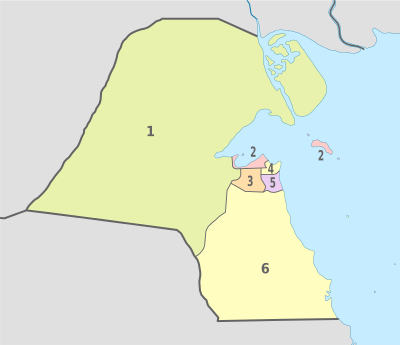 |
|---|---|---|---|---|---|
| 1 | Al Jahra3) | Al Jahra | 12 130 | 272 373 | |
| 2 | Al Asimah (Al Kuwayt)2) | Al Kuwait | 200 | 261 013 | |
| 3 | Al Farwaniyah | Al Farwaniyah | 190 | 622 123 | |
| 4 | Hawalli | Hawalli District | 84 | 487 514 | |
| 5 | Mubarak Al-Kabeer | Mubarak Al-Kabeer | 94 | 176 519 | |
| 6 | Al Ahmadi1) | Al Ahmadi | 5 120 | 393 861 | |
| TOTAL | 17 818 | 2 213 403 |
- 1) The Neutral Zone was dissolved on 18 December 1969, and the northern part with 2590 km² was added to Al Ahmadi (with small part in the northwest added to Al Jahra)
- 2) including the islands of Failaka, Miskan, and Auhah
- 3) including the islands of Warbah and Bubiyan
Economy
Kuwait has a GDP ( PPP) of US$167.9 billion and a per capita income of US$81,800, making it the 5th richest country in the world, per capita. In 2011, estimated exports stood at US$94.47 billion and imports were around US$22.41 billion. Petroleum, petrochemical products, fertilizers and financial services are major export commodities. Kuwait imports a wide range of products ranging from food products and textiles to machinery. Kuwait's most important trading partners are Japan, United States, India, South Korea, Singapore, China, European Union and Saudi Arabia. Japan is the largest customer of Kuwaiti oil followed by India, Singapore and South Korea.
According to the 2008 Index of Economic Freedom, Kuwait has the second-most free economy in the Middle East. In March 2007, Kuwait's foreign exchange reserves stood at US$213 billion. The Kuwait Stock Exchange, which has about 200 firms listed, is the second-largest stock exchange in the Arab world with a total market capitalization of US$235 billion. In 2007, the Kuwaiti government posted a budget surplus of US$43 billion.
Non-petroleum industries include shipping, construction, cement, water desalination, construction materials and financial services. Kuwait has a well developed banking system. The National Bank of Kuwait is the largest bank in the country and one of the largest in the Arab world. Other prominent financial institutions based in Kuwait include the Gulf Bank of Kuwait and Burgan Bank, which is named after the largest oilfield in the country.
The government is keen on decreasing Kuwait's dependence on oil to fuel its economy by transforming it into a regional trading and tourism hub. The planned US$77 billion Madinat al-Hareer (City of Silk) is the largest real estate development project in the Middle East. The Central Bank issues Kuwait's currency, the Kuwaiti dinar. As of May 2012, the dinar is the highest-valued currency unit in the world.
Petroleum industry
Kuwait has proven crude oil reserves of 104 billion barrels (15 km³), estimated to be 10% of the world's reserves. According to the Kuwaiti constitution, all natural resources in the country and associated revenues are government property. Being a tax-free country, Kuwait's oil industry accounts for 80% of government revenue. Petroleum and petrochemicals accounts for nearly half of GDP and 95% of export revenues. Increase in oil prices since 2003 resulted in a surge in Kuwait's economy.
Kuwait currently pumps 2.9 million bpd and its full production capacity is a little over 3 million bpd, including oil production in the neutral region that it shares with Saudi Arabia. Kuwait oil production is expected to increase to 4 million bpd by 2020. To realize this production target, Kuwait Petroleum Corporation plans to spend US$51 billion between 2007 to 2012 to upgrade and expand the country's existing refineries. However, the country's economy was badly affected by the global financial crisis of 2008. In 2009, the Central Bank of Kuwait devised a US$5.15 billion stimulus package to help boost the economy.
Transportation

Kuwait has an extensive, modern and well-maintained network of highways. Roadways extended 5,749 km, of which 4,887 km is paved. In 2000, there were some 552,400 passenger cars, and 167,800 commercial taxis, trucks, and buses in use. On major highways the maximum speed is 120 km/h. Since there is no railway system in the country, most of the people travel by automobiles. The government plans to construct US$11 billion rail network which will include the Kuwait Metropolitan Rapid Transit System Project for its capital. Bus services are provided by private company Citybus and state-owned Kuwait Public Transportation Corporation.
Kuwait has speed cameras in all highways and main roads and traffic lights, which captures the cars that speed or cross a red light, the Kuwaiti government spent over 450 million USD on these speed cameras in cooperation with the traffic Police. There is only one civil airport in Kuwait. Kuwait International Airport serves as the principal hub for international air travel. State-owned Kuwait Airways is the largest airline in the country. In 2001, the airline carried 2,084,600 passengers on domestic and international flights. In 2004, the first private airline of Kuwait, Jazeera Airways, was launched. Another private airline, Wataniya Airways of Kuwait was founded in 2005 and ceased operations in March 2011.
Kuwait has one of the largest shipping industries in the Persian Gulf region. The Kuwait Ports Public Authority manages and operates ports across Kuwait. The country’s principal commercial seaports are Shuwaikh and Shuaiba which handled combined cargo of 753,334 TEU in 2006. Mina Al-Ahmadi, the largest port in the country, handles most of Kuwait's oil exports. Construction of another major port located in Bubiyan island started in 2005. The port is expected to handle 1.3 million TEU when operation starts in 2008.
Demographics
As of 2013, Kuwait's population was estimated to be 2.7 million people, which included 1.3 million non-nationals. The government rarely grants citizenship to foreigners to maintain status quo. The net migration rate of the country stood at 16.01, the third highest in the world.
Ethnic groups
80% of the population in Kuwait is Arab, 9% South and East Asian, and 4% are Iranian. As of 2009, 580,000 Indian nationals were residing in Kuwait, making them the single largest expatriate community there. In 2003, there were also an estimated 250,000 Pakistanis, 260,000 Egyptians, 100,000 Syrians and 80,000 Iranians in Kuwait. After Kuwait was liberated from the Iraqi invasion and occupation by coalition forces led by The United States of America, most of the 400,000 Palestinians living in Kuwait were expelled because of the PLO's open support for the Iraqi Forces. In 2012, there were 80,000 Palestinians residing in Kuwait.
Languages
Kuwait's official language is Modern Standard Arabic. Kuwaiti Arabic, a Gulf Arabic sub-dialect, is Kuwait's colloquial dialect. English is widely understood and often used as a business language.
Religion
About 85% of the population in Kuwait identify themselves as Muslims; there are no official figures, but around 70% are Sunni and 30% are Shi'as. The majority of the Shi'as follow the Twelvers school. Despite Islam being the state religion, the country has a large community of Christians (est. 300,000 to 400,000), Hindus (est. 300,000), Buddhists (est. 100,000), and Sikhs (est. 10,000). Hindus account for the largest number of expatriates in Kuwait. There are Kuwaitis who are Baha'is and Christians, but they are a minority. The Church of Jesus Christ of Latter-day Saints (Mormons) have a ward (congregation) numbering approximately 300 that meet in a villa in Salmiyah. Among its members is the U.S. Ambassador to Kuwait, Matthew H. Tueller.
Christians, Hindus, Sikhs and Buddhists are allowed to build places of worship or other religious facilities. The main Christian church of Kuwait is located in Kuwait City. These groups are allowed to practice and engage in religious activities, including public marriage and other celebrations, without Kuwaiti government interference.
Education
The adult literacy rate in 2008 was 93.9%. Kuwait is directing its attention towards Inclusive Education, which provides opportunity to all children, irrespective of their social class, including children with special needs. Kuwait education system is marked by several achievements in recent years. As of 2005/06 Kuwait allocates 13% of all public expenditure to education, which is comparable to the allocation of public funds to education in many OECD countries but lower than other Arab countries. For the same years the public expenditure on education as a percentage of GDP was 3.9% in 2005/12 which is well below the percentage of GDP spent by OECD countries on education.
Kuwait is facing challenges in improving the quality of education at all levels and to build capacities of students' from a young age. The Ministry of Education is also making efforts to incorporate women into the educated workforce through various programs, for instance the 1989 initiative to establish daytime literacy clinics for women. The Kuwaiti government also offers scholarships to students accepted in universities in United States, United Kingdom and other foreign institutes.
According to the Webometrics Ranking of World Universities, the top-ranking universities in the country are Kuwait University (2499th worldwide), the College of Technological Studies (3769th) and Arab Open University Kuwait (6725th).



